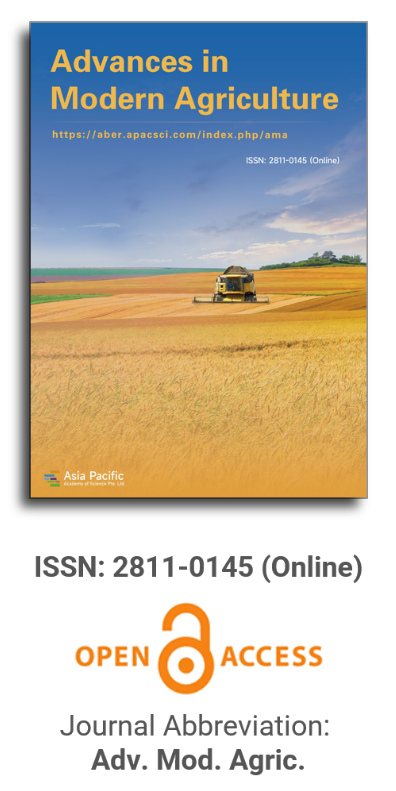


Analytical economic study of rice supply response in Egypt
Vol 5, Issue 4, 2024
VIEWS - 2659 (Abstract)
Download PDF
Abstract
Recent studies have identified several challenges associated with rice production, which hinder the achievement of self-sufficiency in rice. As a crop that heavily relies on irrigation water, rice production has implications for the nation’s water security. Nevertheless, there is still hope for reducing the future food gap by implementing agricultural policies that encourage farmers to increase production. Therefore, it has become essential to understand the responsiveness of rice cultivation area supply to changes, as this is crucial for making decisions regarding agricultural policies related to production and farm prices during the period from 2010 to 2023. The aim is to estimate farmers’ responsiveness, and the time required to achieve this response, as well as the supply elasticity. To achieve the research objective, both descriptive and quantitative statistical analysis were used, applying the Stepwise method in its logarithmic form to estimate the Supply Response. The elasticity of supply response for the rice cultivation area was estimated to be approximately 1.86% in the short term and 2.09% in the long term. It was also found that the response time of the cultivated rice area supply in Egypt to changes is low, estimated at around 1.12. This may be due to the inability to expand the cultivated area of this crop in the following year, as rice cultivation requires large amounts of water, posing a challenge given the scarcity of water resources. Additionally, farmers aim to maximize profits from the crops they cultivate.
Keywords
References
- Rice|USDA Foreign Agricultural Service.
- Egypt Rice Area, Yield and Production (usda.gov).
- Fisher. Irving, Note on a Short– Cut Method for calculating Distributed Lags, Inter Stat. Inst. Bulletin, Vol. 29, 1937.
- Nerlove, Marc Leon, Distributed Lags and Estimation of Long-run Supply and Demand Elasticity’s: Theoretical Consideration, Jour. Farm Econ., Vol. 40, No. 2, 1958.
- Nerlove, Marc Leon, On the Estimation of Long-Run Elasticity’s: A Reply. Jour. Farm Econ., Vol. 41, 1959.
- Solow, Robert, On a Family of Lag Distribution, Econometrics, Vol. 28, No 2, 1960.
- Cochran, Willard, W., Some Further Reflections on Supply control, Jour. Farm. Econ. Vol. 41 No 4, Nov. 1959.
- Al-Saeed Abd El-Hamed Al-Basiouni and others, An analytical study of supply response and econometric models of the most important Egyptian vegetable crops, Egyptian Journal of Agricultural Economics, Vol. 7, No. March 1997.
- Hawraa Jaafar Mohammed & Ahmed Mahmoud Fares, Determinants of the Response of Lentil Cultivated Areas in Iraq for the Period (1980-2003), Journal of Administration and Economics, University of Baghdad, Iraq, No. 79, 2009.
- Jorgenson, Dale, Rational Distributed Lag Functions, Econometrics, Vol. 34, No, 1, 1966.
- Almon, Shirly, Distributed Lag Between Capital Appropriations and Expenditures, Econometrics, Vol. 33, No. 1, 1965.
- Almon Shirly, Lags between Investment Decisions and Their Causes, Rev. Econ. Stat., Vol. 50, 1968.
- Rasha M. A. Farag, An Economic Study of Some Response Supply Determinants of Rice Crop in Egypt, Egyptian Journal of Agricultural Economics, Vol. 29, No. 3, pp. 1127-1138, September 2019.
- Mohamed A. Attala & Mona H. G. Ali, An Econometric Study of Long-Term Equilibrium Relationships for Some Strategic Crops in Egypt, Egyptian Journal of Agricultural Economics, Vol. 26, No. 1, pp. 75-98, March 2016.
- Hammad H. Ahmed & Dalia A. Yassin & Enas M. A. Saleh, The Most Important Factors Affecting the Response of Rice Supply in Egypt, Egyptian Journal of Agricultural Economics, Vol. 20, No. 4, pp. 1-17, December 2010.
- S. M. Abo Zeed and M. M. M. Hamdan, Economic Study on Winter Onion Crop in Sohag Governorate, Minia Journal of Agric. Res. & Develop., Vol. (30) No. 2, pp. 343-362, 2010.
- Momtaz Nagy Mohamed El-Sebaei, An Econometric Study of Supply Response of The Most Important Cereal Crops in Egypt, Alex. J. Agric. Res., Vol. 60, No. 2, pp. 353‐372, 2015.
- Momatze Nagy El-Sebaei, An Econometric study of Supply Response of the most important cereal crops in Egypt, Alex. Agric. Res. Vol. 60, No. 2, PP. 353-372, 2015.
- Mekawy, Mona Mahmoud “An Economic Study of Rice Crop in Egypt” Egyptian Journal of Agricultural Economics, Vol. 31, No. 2, pp. 678-708, 2021.
Supporting Agencies
Copyright (c) 2024 Rehab A. H. Awad, Dina F. M. Enany, Amr S. S. El Sayed, Taher Kadah
License URL: https://creativecommons.org/licenses/by/4.0/

This site is licensed under a Creative Commons Attribution 4.0 International License (CC BY 4.0).

Prof. Zhengjun Qiu
Zhejiang University, China

Cheng Sun
Academician of World Academy of Productivity Science; Executive Chairman, World Confederation of Productivity Science China Chapter, China
Indexing & Archiving
In the realm of modern agriculture, the integration of cutting-edge technologies is revolutionizing the way we approach sustainable farming practices. A recent study published in Advances in Modern Agriculture titled "Classification of cotton water stress using convolutional neural networks and UAV-based RGB imagery" has garnered significant attention for its innovative approach to precision irrigation management. Conducted by researchers from Institute of Data Science and the AgriLife Research and Extension Center of Texas A&M University (authors's information is below). This study introduces a novel method for classifying cotton water stress using unmanned aerial vehicles (UAVs) and convolutional neural networks (CNNs), offering a powerful solution for optimizing water use in agriculture.
Modern agricultural technology is evolving rapidly, with scientists collaborating with leading agricultural enterprises to develop intelligent management practices. These practices utilize advanced systems that provide tailored fertilization and treatment options for large-scale land management.
This journal values human initiative and intelligence, and the employment of AI technologies to write papers that replace the human mind is expressly prohibited. When there is a suspicious submission that uses AI tools to quickly piece together and generate research results, the editorial board of the journal will reject the article, and all journals under the publisher's umbrella will prohibit all authors from submitting their articles.
Readers and authors are asked to exercise caution and strictly adhere to the journal's policy regarding the usage of Artificial Intelligence Generated Content (AIGC) tools.
Asia Pacific Academy of Science Pte. Ltd. (APACSCI) specializes in international journal publishing. APACSCI adopts the open access publishing model and provides an important communication bridge for academic groups whose interest fields include engineering, technology, medicine, computer, mathematics, agriculture and forestry, and environment.



.jpg)
.jpg)

.jpg)
